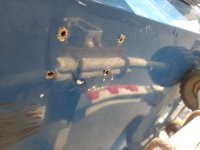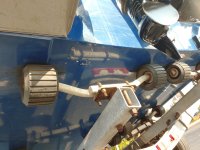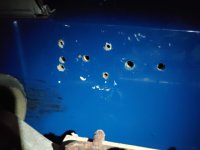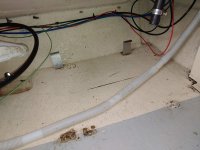I found four holes that I have not seen before. Ugh.
This boat had a major overhaul before I got it and the previous owner hadn't even used it. He hadn't seen them either.
So it's been in the water about 100 hours total. I'm guessing there was a transducer or something there. The transducer is now mounted on the starboard side on the back not the bottom. It's possible that the person who did the gelcoat had covered them with a plate and it has fallen off but more likely I think that they just never got filled. When I took the pics I didn't think to probe them. I'm getting the boat from storage tomorrow and will poke around and see if they dead end or what.
I guess I fill them and sand it flat, but I'm concerned about what could have happened with it like this. I have two batteries in the starboard lazaret and the boat lists to that quarter a lot, the water line is below water a couple inches there. To get it level only takes a little downward force to the port quarter when I'm standing on the dock, so I think the level is just off from the batts. The holes are on the port quarter, but for all I know water has been pouring into some third-space... I don't know how the hull is constructed on the bottom.
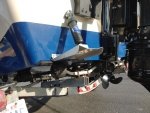
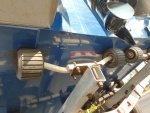
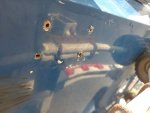
Thanks for your ideas on what I should check or do.
This boat had a major overhaul before I got it and the previous owner hadn't even used it. He hadn't seen them either.
So it's been in the water about 100 hours total. I'm guessing there was a transducer or something there. The transducer is now mounted on the starboard side on the back not the bottom. It's possible that the person who did the gelcoat had covered them with a plate and it has fallen off but more likely I think that they just never got filled. When I took the pics I didn't think to probe them. I'm getting the boat from storage tomorrow and will poke around and see if they dead end or what.
I guess I fill them and sand it flat, but I'm concerned about what could have happened with it like this. I have two batteries in the starboard lazaret and the boat lists to that quarter a lot, the water line is below water a couple inches there. To get it level only takes a little downward force to the port quarter when I'm standing on the dock, so I think the level is just off from the batts. The holes are on the port quarter, but for all I know water has been pouring into some third-space... I don't know how the hull is constructed on the bottom.



Thanks for your ideas on what I should check or do.

